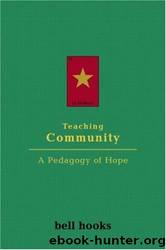Teaching Community by Hooks Bell

Author:Hooks, Bell [Hooks, Bell]
Language: eng
Format: epub
Tags: feminism, Sociology, Politics, Philosophy
ISBN: 9780415968188
Amazon: 0415968186
Goodreads: 833590
Publisher: Routledge
Published: 2002-11-30T08:00:00+00:00
Importantly, Kaufman and Raphael identify the âinner voiceâ of a âsceneâs conscious residueâ that may lead an individual to be self-shaming. For example: a black child told repeatedly that he or she is stupid and not to act stupid before whites may fear being stupid. When faced with a white teacher who treats them like they are stupid these children may activate that internal shaming voice. This can happen with a student who may be exceptionally intelligent but who may dis-count their worth because the inner voice says that they are really stupid. Kaufman and Raphael state that âthe principal effects of shame on the self are hiding, paralysis, and a feeling of being transparent.â They contend: âThe urge to hide and disappear from view immediately follows shame because we desperately want to reduce the agonizing scrutiny.â I would add to this that being the object of intense scrutiny can trigger shame-based re-enactment of painful scenarios. Often black students, students of color, and gay students of all races seek out classes where they are in the majority or social spaces to avoid being âseenâ and shamed.
Many black students with excellent academic skill and talent are performing poorly in academic settings because they are shame-based and in settings where shaming is a common practice. In many cases simply the experience of being
âjudgedâ activates deep-seated feelings of shame. Messing up, performing poorly eases the anxiety. If the fear is that they will be found wanting, then as soon as they can inappropriately act out so that they are indeed wanting, they can feel better. There are serious taboos against acknowledging shame. Individual
Moving beyond Shame
101
black students and colleagues have broken down emotionally as we talk in my office about negative experiences in predominantly white academic settings. They voice shame about feeling shame. One dark-skinned male student confessed that every time he was asked a question in a class where everyone else was white he felt inwardly terrified of failure and he always responded with anger. Even though he could see that this response alienated him from his peers he felt stuck.
With keen insight Kaufman and Raphael identify rage as the most common secondary reaction to shame. They explain:
âWhen the intensity of shame reaches the highest levels, rage is triggered. Rage serves a vital self-protective function: it shields the exposed self. At certain times, rage actively keeps everyone away, covering the self. We refuse further contact because rage has shut us in and others out. But at other times rage in response to shame may make us invite or seek direct contact with whoever has humiliated usâif for no other reason than to strike back . . . That is why if we feel worthless or inadequate . . . we often mask our deeper shame with surface rage.â Often individual students of color, and other marginalized students, are consumed by feelings of rage. Their anger blinds them, preventing them from taking needed steps to restore their integrity of being and personal agency.
Until the
Download
This site does not store any files on its server. We only index and link to content provided by other sites. Please contact the content providers to delete copyright contents if any and email us, we'll remove relevant links or contents immediately.
| Administration | Assessment |
| Educational Psychology | Experimental Methods |
| History | Language Experience Approach |
| Philosophy & Social Aspects | Reform & Policy |
| Research |
The Art of Coaching Workbook by Elena Aguilar(51080)
Trainspotting by Irvine Welsh(21573)
Twilight of the Idols With the Antichrist and Ecce Homo by Friedrich Nietzsche(18570)
Fangirl by Rainbow Rowell(9179)
Periodization Training for Sports by Tudor Bompa(8214)
Change Your Questions, Change Your Life by Marilee Adams(7687)
This Is How You Lose Her by Junot Diaz(6835)
Asking the Right Questions: A Guide to Critical Thinking by M. Neil Browne & Stuart M. Keeley(5709)
Grit by Angela Duckworth(5557)
Red Sparrow by Jason Matthews(5428)
Paper Towns by Green John(5141)
Room 212 by Kate Stewart(5073)
Ken Follett - World without end by Ken Follett(4684)
Housekeeping by Marilynne Robinson(4395)
The Sports Rules Book by Human Kinetics(4344)
Double Down (Diary of a Wimpy Kid Book 11) by Jeff Kinney(4242)
Papillon (English) by Henri Charrière(4228)
The Motorcycle Diaries by Ernesto Che Guevara(4053)
Exercise Technique Manual for Resistance Training by National Strength & Conditioning Association(4023)
